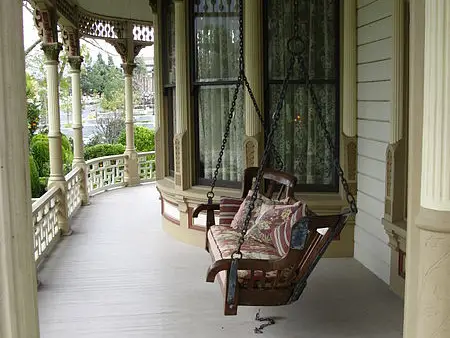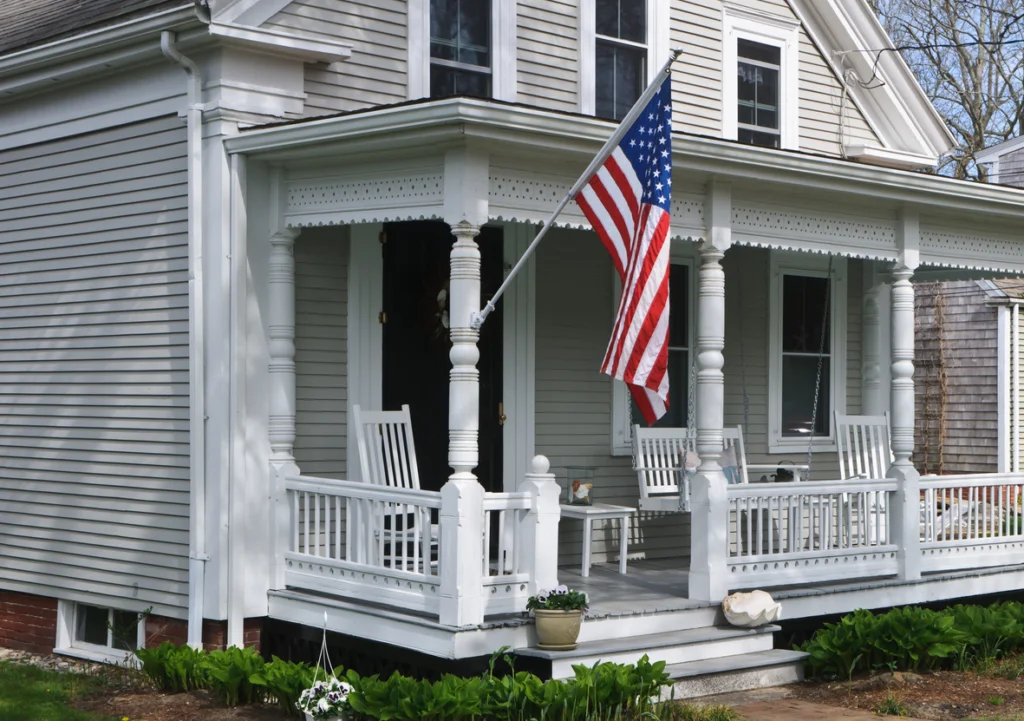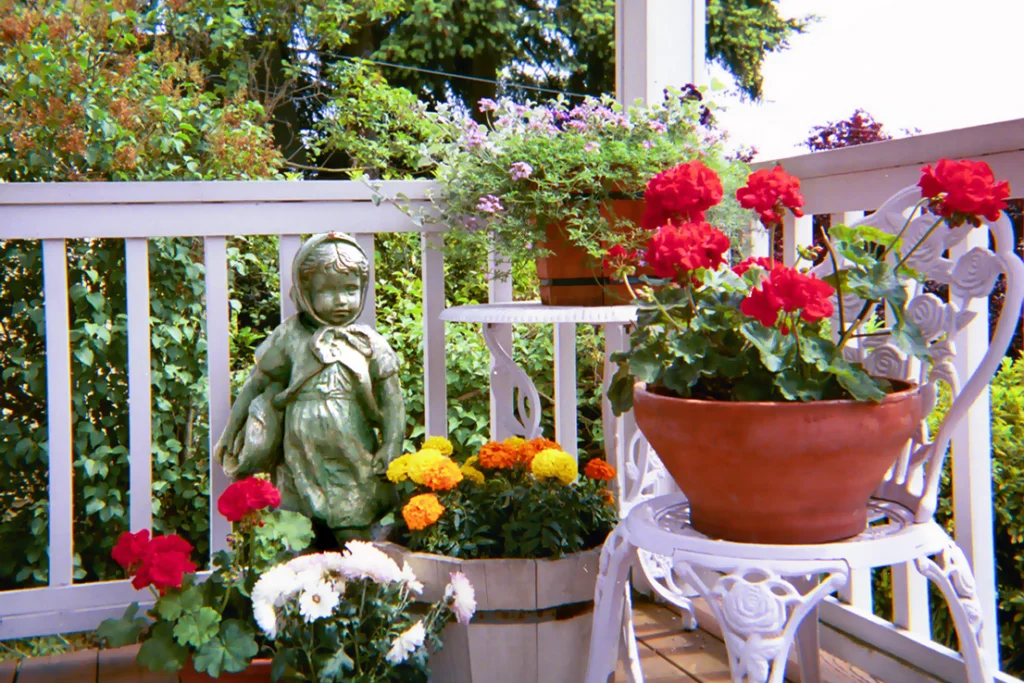Long before social media profiles revealed our personalities, front porches were the original status updates. What families chose to display—or not display—on that small slice of real estate between their private sanctuary and the public world spoke volumes about values, interests, and the very heartbeat of the household. Take a nostalgic stroll down memory lane as we explore how these 14 porch items told stories without saying a word.
1. The Porch Swing

A well-worn wooden porch swing announced a family that valued conversation and togetherness above all else. Often handed down through generations, these swings represented tradition, with their creaking chains telling tales of courtships, heart-to-hearts, and lazy Sunday afternoons. You could always tell how social a family was by the position of their swing—facing the street meant they welcomed neighborhood chat, while angled toward the door suggested more private family moments. Family Fence Factory writes that these features have a history that’s as rich as the decor is appealing for a home to have.
The maintenance of the swing itself told another story entirely about the household. A freshly painted swing with plump cushions signaled a house proud matriarch or a father who took pride in home upkeep, while a weathered swing with character meant here lived a family too busy making memories to fuss over appearances. Children’s books tucked into the corners or a hidden bottle of something sweet stashed underneath were little mysteries that revealed the swing’s true purpose—a sanctuary where time slowed down just enough to savor life’s simple pleasures.
2. The American Flag

A crisp American flag flying proudly announced a household that held patriotism as a core value, often indicating a veteran lived within those walls. How the flag was displayed—whether permanently mounted, brought in each evening with ceremony, or flown only on holidays—revealed the depth of the family’s connection to national traditions. The condition of the flag itself, whether bright and new or respectfully weathered, showed how the family balanced symbolism with practicality. American Pacific Mortgage goes further into proper decorum for properly displaying an American flag on the porch.
Families that paired their American flag with other symbols—a POW/MIA flag, a service branch pennant, or even state flags—were telling a more nuanced story about their specific allegiances and history. The homes that illuminated their flags at night or followed proper flag etiquette to the letter were often those with the strongest military connections or civic pride. Children from these homes could typically recite the Pledge of Allegiance before kindergarten and understood the weight of responsibility that came with being an American.
3. The Rocking Chair Collection

Multiple rocking chairs, especially those arranged in a conversational circle, signaled a family that valued community connection and operated with an open-door policy. The variety of chairs often told the story of the generations within—a large Adirondack-style rocker for grandpa, a delicate wicker one for grandma, and smaller versions for the little ones in training. These families believed in the power of “porch sitting” as an activity unto itself, treating the front porch as an outdoor living room where problems were solved and wisdom was shared. According to Van Dyke’s Restorers the rocking chair itself has a fascinating history, as does the practice of displaying it on the porch, which dates back centuries and crosses oceans.
The rocking chair family typically kept a small table nearby with a pitcher of something cold—sweet tea in the South, lemonade up North—ready to offer refreshment to any neighbor who happened by. Conversation flowed as steadily as the rocking motion, with these families serving as the neighborhood’s unofficial information hub and support system. Children raised in these homes learned the art of storytelling and the importance of community by osmosis, absorbing life lessons while adults chatted above their heads.
4. The Welcome Mat

The specific wording on a welcome mat revealed surprising insights about the family’s attitude toward visitors and their sense of humor. A simple “Welcome” suggested straightforward hospitality, while clever wordplay or sassy messages (“The neighbors have better stuff”) hinted at a household that valued wit and didn’t take itself too seriously. The cleanliness and positioning of the mat—perfectly centered or askew—often reflected the overall orderliness of the home inside. If rocking chairs on porches have a long history, History Oasis reports that the welcome mat as a concept dates back even thousands of years.
Seasonal or themed welcome mats showed a family that embraced celebrations and likely decorated for every holiday with equal enthusiasm. These homes typically had children whose school projects adorned refrigerators and parents who volunteered for community events. Worn-out welcome mats that had clearly seen years of use but remained in place spoke of practical families who valued function over appearance and likely held onto traditions with the same tenacity.
5. The Porch Plants

The variety and health of potted plants adorning a porch told an entire story about the caregivers inside the home. Lush, thriving plants arranged with artistic intention suggested patient nurturers who paid attention to details and likely brought that same careful tending to their relationships. Struggling plants or empty pots with just a hint of dried soil hinted at well-intentioned but perhaps overwhelmed households where aspirations sometimes outpaced reality.
The specific plant choices revealed even more—practical herb gardens belonged to home cooks who valued self-sufficiency, while showy flowering displays came from those who prioritized beauty and took pride in neighborhood appearance. Quirky plant containers made from repurposed items—old boots, vintage watering cans, or hand-painted pots—indicated creative spirits who valued personal expression over conventional decorating rules. The homes with generational plants, massive specimens clearly tended for decades, often housed families with deep roots in the community and strong traditions of passing down both stories and living heirlooms.
6. The Seasonal Decorations

Families that changed their porch decorations with each holiday or season were announcing their celebration of life’s rhythms and their connection to community traditions. The elaborateness of these displays—from simple tasteful wreaths to full-blown themed extravaganzas—reflected not just available leisure time but also the importance placed on marking special occasions. These were often the families whose interior calendars were equally full of birthdays, anniversaries, and meaningful observances that punctuated the year with moments of joy.
The timing of decoration changes told another story entirely—early decorators were enthusiastic planners who approached holidays with childlike anticipation, while last-minute displays suggested busy households caught up in life’s demands but still making the effort. Handmade decorations versus store-bought ones distinguished the DIY-proud family from those who valued convenience or professional aesthetics. Children from these homes typically grew up with rich seasonal traditions and strong associations between physical symbols and emotional experiences, carrying these connections into their own adult households.
7. The Porch Light

The humble porch light, often overlooked, revealed subtle but important family values through its selection and use patterns. Families that invested in distinctive, high-quality lighting fixtures were generally house-proud and community-minded, understanding that this small detail contributed to both curb appeal and neighborhood safety. Those who participated in community-wide symbolic lighting—blue bulbs for autism awareness, green for veterans—showed their engagement with causes beyond their own four walls.
The timing of when porch lights came on and went off told perhaps the most revealing story—automatic dusk-to-dawn settings suggested practical, energy-conscious households, while lights left on all night often indicated security-minded families or those with shift workers coming home in darkness. Homes where the porch light burned welcomingly late into evening hours typically housed social families who entertained frequently or parents waiting up for teenagers to return safely. The carefully maintained light, with no cobwebs or dead insects, generally signaled attention to detail that carried throughout the home.
8. The Screen Door

The distinct slap of a wooden screen door served as the soundtrack to summer for generations, and its presence announced a household that embraced fresh air and informal living. Families that maintained traditional wooden screen doors with their characteristic spring mechanisms were often nostalgic at heart, valuing connections to simpler times even if it meant more maintenance. The decorative details chosen—whether plain and functional or ornate and personalized—reflected the family’s balance between practicality and aesthetics.
The rules surrounding the screen door revealed even more about family dynamics—houses where “Don’t slam the screen door!” was frequently shouted typically housed parents trying to maintain standards while raising energetic children. Homes with screen doors propped open on pleasant days welcomed both breezes and drop-in visitors, suggesting an easy-going attitude toward boundaries and household containment. Screen doors adorned with children’s handprints or pet nose smudges at various heights told the most honest story of all—here lived a family that prioritized living fully over maintaining perfect appearances.
9. The Porch Furniture Arrangement

The specific arrangement of porch furniture—whether formally balanced or casually scattered—reflected the family’s approach to both entertaining and relaxation. Chairs arranged in a perfect circle facilitated eye contact and suggested a household that valued deep conversation and connection, while furniture facing the street indicated neighborhood watchers who enjoyed passive participation in community life. Mismatched furniture collected over time rather than purchased as a set often belonged to practical families who valued comfort and function over coordinated aesthetics.
The wear patterns on cushions and furniture told stories of routine and preference—the extra-worn chair that was clearly “Dad’s spot” or the small table positioned perfectly for morning coffee revealed the rituals that structured family life. Homes where furniture could be easily rearranged typically belonged to adaptable families who adjusted to circumstances rather than imposed rigid structures. The presence of child-sized furniture alongside adult pieces announced multi-generational living where everyone’s comfort mattered equally.
10. The Doorbell or Door Knocker

The choice between a musical doorbell, a traditional knocker, or simply encouraging visitors to “just holler when you get here” revealed surprising insights about how a family managed boundaries. Elaborate doorbell systems with multiple tones or chimes often belonged to large families where identifying visitors at different entrances was practical necessity rather than ostentation. Decorative knockers—whether whimsical animals or elegant brass rings—suggested appreciation for tradition and ritual surrounding the act of welcoming others into one’s space.
Homes where the doorbell was perpetually broken but never repaired typically housed laid-back families who valued relationships over formalities and believed in permeable boundaries between inside and outside worlds. The doorbell that triggered visible dog excitement or sent children running to be “first” to greet visitors revealed households where arrivals were celebrated rather than merely accommodated. Families with “Please Don’t Ring—Baby Sleeping” signs temporarily posted showed the adaptability of household systems to changing life stages.
11. The House Number Display

The styling and prominence of house numbers revealed a family’s practical sensibilities and community-mindedness in subtle ways. Oversized, artistic, or illuminated numbers suggested awareness of emergency services’ needs and consideration for delivery drivers and first-time visitors trying to locate the home. The specific aesthetic chosen—rustic wooden planks, elegant brass numerals, or quirky custom designs—aligned with the family’s overall approach to home presentation.
Homes where numbers were partially obscured by overgrown plants or faded beyond recognition often housed long-term residents who navigated by landmark rather than address (“We’re the yellow house after the big oak tree”) and assumed others would do the same. The positioning of numbers—whether at the road, on the mailbox, above the garage, or directly on the porch—indicated the family’s thinking about visibility and how they primarily expected to receive visitors. Multiple displays of the same house number in different locations typically reflected a safety-conscious household with at least one worrier in residence.
12. The Mailbox

Whether mounted by the front door or positioned at the curb, a mailbox’s style and condition offered telling clues about the household’s communication patterns and priorities. Hand-painted or custom-designed mailboxes often belonged to creative families who valued self-expression and saw even utilitarian objects as opportunities for personalization. Oversized mailboxes bursting with catalogues and magazines revealed households that maintained numerous external connections and likely had diverse interests.
The timing of mail collection told another story—homes where mail was promptly retrieved each day typically housed organized individuals who stayed on top of correspondence and financial matters. Mailboxes with “No Junk Mail Please” notices suggested environmentally-conscious families or those who guarded their time and attention carefully. The presence of children’s artwork temporarily decorating the mailbox or seasonal mailbox covers indicated a household that included even the smallest family members in traditions of home pride and celebration.
The front porch has always been America’s in-between space—not quite public, not fully private—where families revealed carefully curated glimpses of their interior lives. While modern homes often minimize these transitional spaces in favor of privacy and security, those traditional front porches remain powerful symbols of a time when neighborhoods truly functioned as communities. Perhaps in recognizing what these porch items once silently communicated, we might find ourselves inspired to be more intentional about what we choose to display in our own in-between spaces today.


